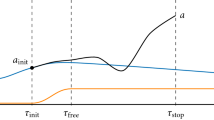Abstract
In the present paper, literal analytical solutions in power series forms are developed for the radius of curvature and the expansion velocity of the zero pressure cosmological models of the universe at any time t. Also, we develop literal analytical solutions in power series forms for the inverse problem of the zero pressure cosmological model, that is to find the time \(t=\tilde{t}\) (say) at which the radius of curvature of the model \(R=\tilde{R}\) (say) is known. The importance of these analytical power series representations is that, they are invariant under many operations because, addition, multiplication, exponent ion, integration, different ion, etc of a power series is also a power series. A fact which provides excellent flexibility in dealing with analytical as well as computational developments of the problems related to zero pressure cosmological models.For computational developments of these solutions, an efficient method using continued fraction theory is provided. By means of the present methods we able to analyze some known zero-pressure cosmological models, of these are Einstein and De Sitter models. In addition we also analyzed some other models by which one can know if the universe keep expanding forever, or will it reach a maximal size and then turn into contraction stage.
Similar content being viewed by others
References
Battin, R.H.: An Introduction to the Mathematics and Methods of Astrodynamics, Revised edition. AIAA, Education Series, Reston (1999)
Gautschi, W.: Computational aspects of three-term recurrence relations. SIAM Review, 9(1) (1967)
Grigoris, P.: Comparison between different cosmological models. Phys. Rev. D 77(10), 107303 (2008)
Hao, W., Nan, Z.S.: Observational data and cosmological models. Phys. Lett. B 664(1), 7 (2007)
Marek, S.: Cosmological zoo-accelerating models with dark energy. J. Cosmol. Astropart. Phys. (9), 7 (2007)
Misner, C., Thorne, K., Wheeler, A.: Gravitation. Freeman, New York (1973)
Prialnik, D.: An Introduction to the Theory of Stellar Structure and Evolution. Cambridge University Press, Cambridge, New York (2007)
Puxun, W., Nan, Z.S.: Cosmological evolution of the interacting phantom (quintessence) model in loop quantum gravity. J. Cosmol. Astropart. Phys. (6), 7W (2008)
Robinson, R.M.: The Cosmological Distance Ladder. W.H. Freeman New York (1985)
Smart, W.M.: Celestial Mechanics. Longmans Green and Co., London (1953)
Tianx, Z.: A new cosmological model: black hole universe. In: AAS Meeting 21115204Z (2007)
Author information
Authors and Affiliations
Corresponding author
Rights and permissions
About this article
Cite this article
Sharaf, M.A. Symbolic analytical developments of the zero pressure cosmological model of the universe. Astrophys Space Sci 318, 133–140 (2008). https://doi.org/10.1007/s10509-008-9896-2
Received:
Accepted:
Published:
Issue Date:
DOI: https://doi.org/10.1007/s10509-008-9896-2




